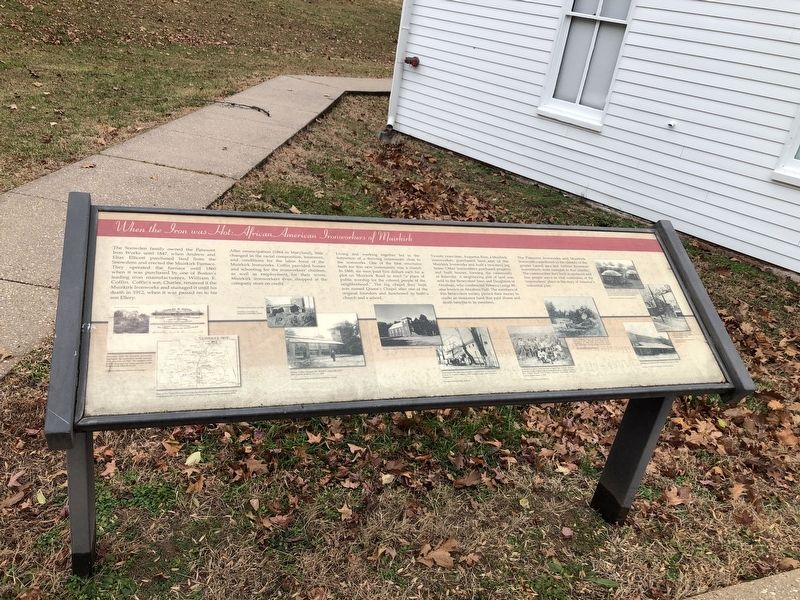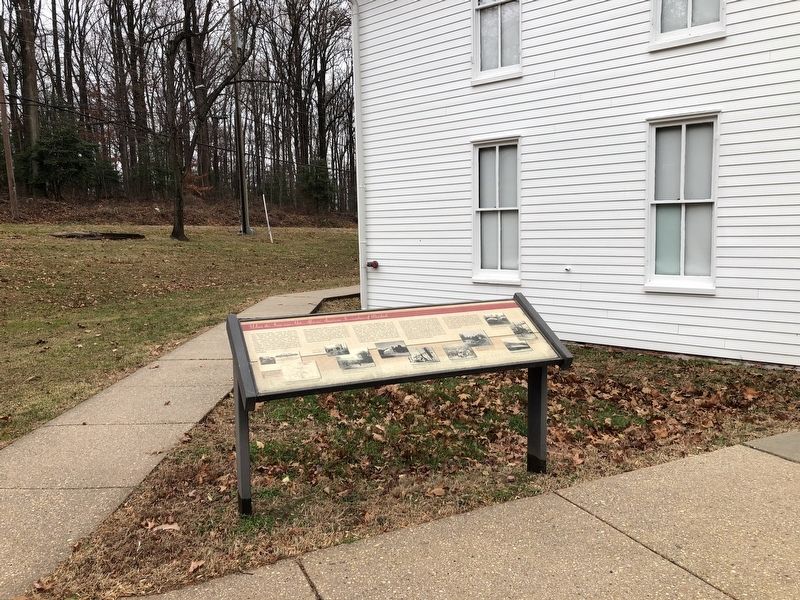Near Beltsville in Prince George's County, Maryland — The American Northeast (Mid-Atlantic)
When the Iron was Hot: African American Ironworkers of Muirkirk

Photographed By Devry Becker Jones (CC0), December 11, 2021
1. When the Iron was Hot: African American Ironworkers of Muirkirk Marker
The Snowden family owned the Patuxent Iron Works until 1847, when Andrew and Elias Ellicott purchased land from the Snowdens and erected the Muirkirk Furnace. They operated the furnace until 1860 when it was purchased by one of Boston's leading iron manufacturers, William E. Coffin. Coffin's son, Charles renamed it the Muirkirk Ironworks and managed it until his death in 1912, when it was passed on to his son Ellery.
After emancipation (1864 in Maryland), little changed in the racial composition, treatment and conditions for the labor force of the Muirkirk Ironworks. Coffin provided homes and schooling for the ironworkers' children, as well as employment for their wives. Muirkirk ironworkers even shopped at the company store on credit.
Living and working together led to the formation of a thriving community close to the ironworks. One of the first structures built for this new community was a church. In 1868, six men paid five dollars each for a plot on Muirkirk Road to erect "a place of public worship for the colored people of the neighborhood." The log chapel they built was named Queen's Chapel after one of the original founders and functioned as both a church and a school.
Twenty years later, Augustus Ross, a Muirkirk ironworker, purchased land east of the Muirkirk Ironworks and built a two-story log home. Other ironworks purchased property and built houses, forming the community of Rossville. A neighborhing plot of land was sold to the Benevolent Sons and Daughters of Abraham, who constructed Rebecca Lodge #6, also known as Abraham Hall. The members of this benevolent society pooled their money to create an insurance fund that paid illness and death benefits to its members.
The Patuxent Ironworks and Muirkirk Ironworks contributed to the identity of the greater Laurel area and African American ironworkers were essential to that identity. The communities they built as enslaved and free people serve as vital reminders of the ironworkers' place in the story of America's industrial past.
[Captions:]
Stationery from the Muirkirk Ironworks highlights the celebrated tensile strength of its pig iron, ca. 1900. The company also had its own rail and telegraph line on the Baltimore & Ohio Railroad.
Charles Coffin managed the Muirkirk Ironworks from 1860 until his death in 1912, ca. 1904.
Ironworkers with their children in front of homes built for and rented to them by Charles Coffin, ca. 1925. Several families often lived in a single house.
Muirkirk ironworkers. Back row (left to right): John Weems, unknown, Meshach Conway, William Tolliver, Benjamin Conway, unknown. Middle Row: William Stewart, Will Franklin,

Photographed By Devry Becker Jones (CC0), December 11, 2021
2. When the Iron was Hot: African American Ironworkers of Muirkirk Marker
African American men at the Ironworks with the Baltimore & Ohio Railroad tracks visible in the foreground, ca. 1920. After the Ironworks closed, many of Muirkirk's workers got jobs with the railroad.
Charcoal kilns at Muirkirk Ironworks, ca. 1920. Charcoal was manufactured practically year-round. The buildings located closely behind the kilns housed African American workers and their families.
Erected by Maryland-National Capital Parks and Planning Commission.
Topics. This historical marker is listed in these topic lists: African Americans • Churches & Religion • Fraternal or Sororal Organizations • Industry & Commerce • Settlements & Settlers. A significant historical year for this entry is 1847.
Location. 39° 3.55′ N, 76° 52.4′ W. Marker is near Beltsville, Maryland, in Prince George's County. Marker is on Old Muirkirk Road, 0.2 miles north of Muirkirk Road, on the right when traveling north. Touch for map. Marker is at or near this postal address: 7612 Old Muirkirk Rd, Beltsville MD 20705, United States of America. Touch for directions.
Other nearby markers. At least 8 other markers are within walking distance of this marker. Iron Production: Maryland's Industrial Past / The Ironmaking Process (here, next to this marker); Abraham Hall: An African American Benevolent Lodge (here, next to this marker); Three Sisters: Close Knit Communities of the Laurel Area (here, next to this marker); Queen’s Chapel Methodist Church, Established 1868 (approx. 0.2 miles away); The Dinosaurs of Dinosaur Park (approx. 0.8 miles away); Welcome to Dinosaur Park (approx. 0.8 miles away); The Industrial Heritage of Dinosaur Park (approx. 0.8 miles away); Meet Astrodon johnstoni (approx. 0.8 miles away). Touch for a list and map of all markers in Beltsville.
Related marker. Click here for another marker that is related to this marker. This marker has replaced the linked marker.
Credits. This page was last revised on December 11, 2021. It was originally submitted on December 11, 2021, by Devry Becker Jones of Washington, District of Columbia. This page has been viewed 336 times since then and 25 times this year. Photos: 1, 2. submitted on December 11, 2021, by Devry Becker Jones of Washington, District of Columbia.